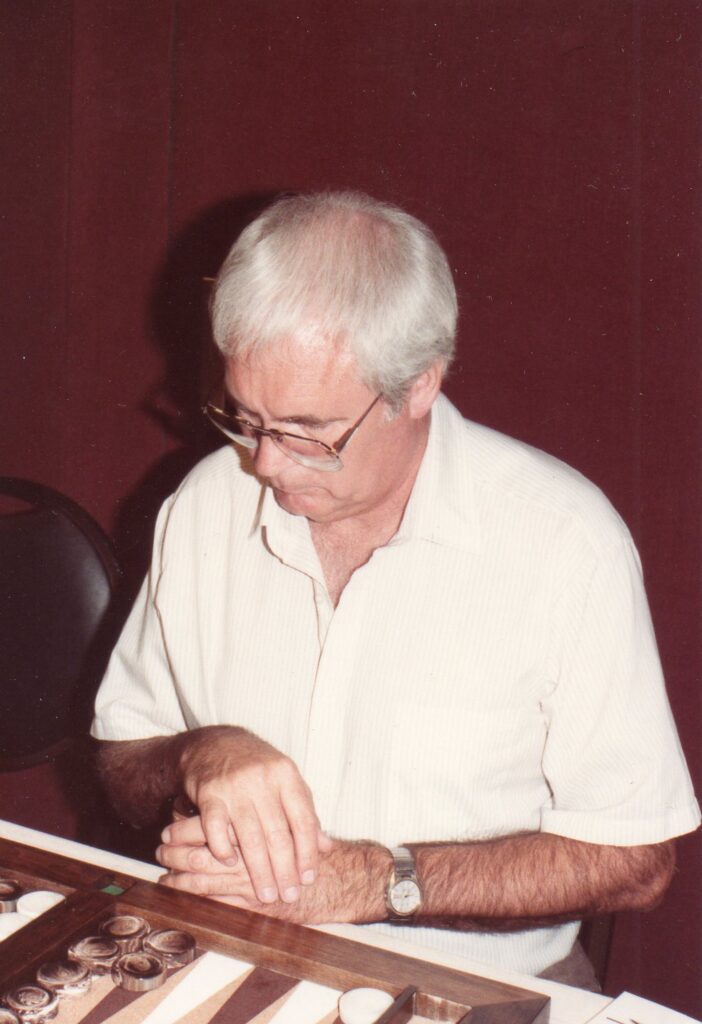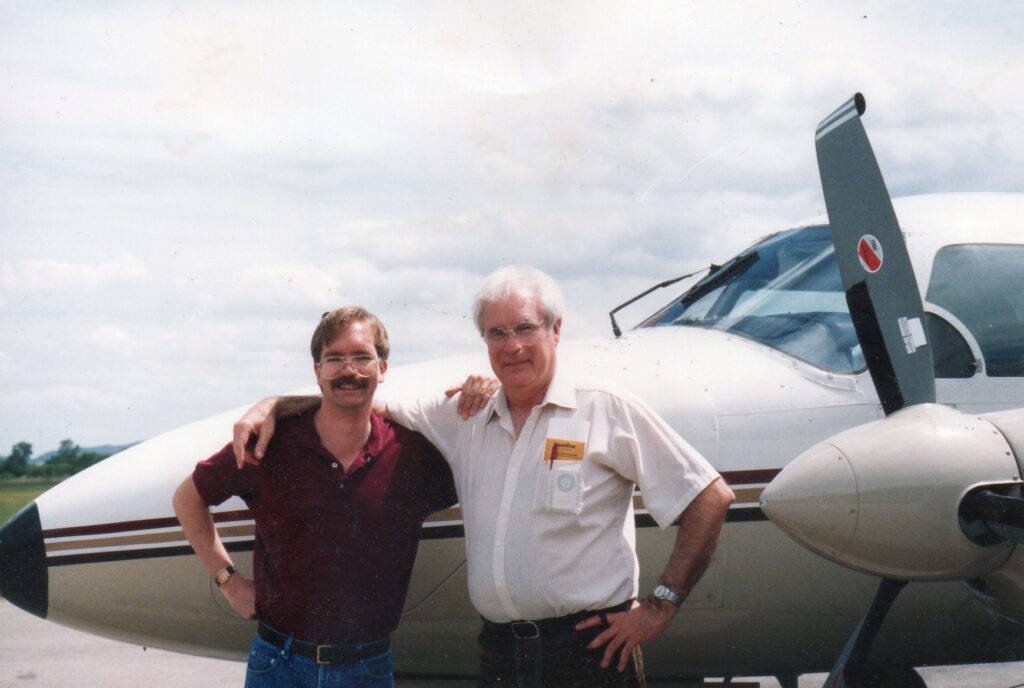A few weeks ago Malcolm Davis sadly passed away, in his late 80s. Malcolm was one of the true giants of the game, a top player for more than 40 years, a fixture at practically every major tournament, and a member of the Backgammon Hall of Fame. The capstone of his tournament career came in 1996, when he won the fifth World Cup, defeating Kit Woolsey in a best-of-five 13-point match final.

In many respects Malcolm was well ahead of his time. In the late 1970s and early 1980s, when pure play ruled the day, Malcolm was one of a few players who sought a more sensible, balanced approach to the game. His excellent tournament results were for a time dismissed as simply good luck. But when Jellyfish and Snowie arrived on the scene, players began to understand that Malcolm and some other “lucky” players had been on the right track all along.
I always enjoyed running into Malcolm at tournaments. He had a wide range of interests and a ton of good stories to share. (Playing him wasn’t that much fun since he beat me like a drum.) Here are a few stories from Malcolm’s life.
MALCOLM’S DEBUT IN THE BIG TIME
Early in his backgammon career Malcolm was a participant in the longest match ever played — a 65-point doubles match against Paul Magriel and Roger Low. How the match came about is a story in itself.
In 1978 Harry Demetriou, owner of the Mont Parnes Hotel and Casino in Athens, decided that his casino needed a little more publicity. Backgammon was becoming hugely popular at that time and especially so in Greece, so what could be better than a big backgammon match? He decided to promote a doubles match between a European team and an American team, to settle the question of where backgammon superiority really resided — with the elegant and distinguished European crowd or the up-and-coming American riffraff?
Picking the leaders of each team wasn’t hard — Joe Dwek was recognized as the top European player, while Paul Magriel, the current World Champion and author of his recently-published Backgammon, was clearly the top American. Each got to pick his playing partner. Dwek picked Kiumars Motakhasses, originally from Iran and now living in Europe. Motakhasses had racked up a string of victories in European tournaments and was generally considered Dwek’s equal. Paul took a different route, going off the boards to pick Roger Low, his fast-developing 20-year old protege. Roger had yet to score any major tournaments wins, but Magriel appreciated his brilliant mind and realized he could be a major asset to the team.
During the summer of 1978 the match dates were announced — October 25-27 in Athens. The contest would be a 63-point match split over three days, the longest match ever played.
Paul realized that a warm-up match for his team might be useful since no one had any experience in matches of such length. Some calls were made and he found a Texas team that was willing to go against them — Tony Goble and Malcolm Davis. Tony Goble might be an unfamiliar name to many current players, but in 1978 he was one of the kings of backgammon. In 1975 he accomplished a feat never matched before or since. He won five major tournaments in one calendar year! Keep in mind that there weren’t nearly as many tournaments then as now and his feat becomes even more impressive. Outside of Texas Malcolm was still pretty much unknown, but if Goble wanted him as a partner then the New Yorkers assumed he must be a real player.
The warm-up match was set for late August in Dallas. It would be a match to 65, two points longer than the upcoming match against the Europeans. The betting line heavily favored the New Yorkers, but the Texas team had one edge — home-court advantage. Texas is all-fire hot in August, and perhaps the city slickers would melt a little in the heat.
The match got off to a rousing start in Game 1. Magriel and Low got an early edge and properly doubled, and the Texas team made a correct take. The game took a turn in their favor, and Goble/Davis promptly shipped it back to 4. The redouble was a little premature but the message was clear — the match would be a shoot-out, not a grinding technical affair. Goble/Davis brought it home and took a 4-0 lead.
The Texans were on a roll and the score kept mounting: 8-1, 12-3, 16-3. The New Yorkers, brimming with confidence at the start, finally found themselves staring at the wrong end of a 22-3 deficit. A 19-point lead! Unthinkable but true. But at this point the luck turned around. A gammon followed by a backgammon cut the deficit to 22-14. Finally, after 25 games, the New Yorkers knotted the score at 28-all. The Texans opened up another 12-point lead at 48-36. Magriel and Low won 14 of the next 15 games to take the lead at 53-49. Five more games and the New Yorkers reached their biggest lead of the match, 58-51 after 60 games! Was this the end? Not at all. The Texans kept fighting. After 69 games the match was tied, 62-62. A three-point match now remained. Fittingly, after 71 games the score was 64-all, and the players settled in for the double-match-point game. The final game had its moments, but Paul and Roger got caught with too many checkers on the bar. Tony and Malcolm won a backgammon and with it the match, 65-64.
Talking to Paul years later, he remarked that he and Roger knew that Tony Goble would be a tough opponent, but they were very surprised at how well this Malcolm Davis played, and how often his suggestions were the very moves they were fearing.
Oh, and the match in Athens? It also reached double match point, but this time Paul and Roger prevailed.
CHATEAU TEXAS
Malcolm was a man of many parts. During the 1990s he became a vintner, opening a vineyard near Dallas that he called Chateau Texas. The specialty was their cabernet sauvignon, and many of Malcolm–s friends were favored with a bottles of the wine, which was actually quite good.
MALCOLM THE RACONTEUR
Malcolm loved to tell stories, which were always entertaining and compelling. And sometimes a little too entertaining. Kent Goulding recalls a memorable incident from the late 1990s.
Every summer Jim Scott, a backgammon enthusiast, would host a week-long chouette and party at his ranch in West Texas. Invited players came from around the country, but since West Texas was a bit off the beaten path, several of them would meet in Dallas and charter a private plane to fly them to Scott’s ranch.
On this particular flight, the plane was pretty full. Malcolm squeezed in next to the pilot, while the other players sat in the rear seats. During the flight Malcolm regaled the pilot with a host of good stories. The pilot listened intently. As they approached the airstrip near Scott’s ranch the pilot divided his attention between catching the last of one of Malcolm’s stories and preparing the plane for landing. The pilot did a pretty good job under the circumstances. He remembered to do everything except — lower the wheels.
When the passengers heard the plane scraping along the runway, they became understandably alarmed. The pilot reacted quickly and lifted the plane back into the air, and they circled the field and landed again, this time with the wheels down. The passengers breathed a sigh of relief, and Malcolm had another story for his repertoire!






